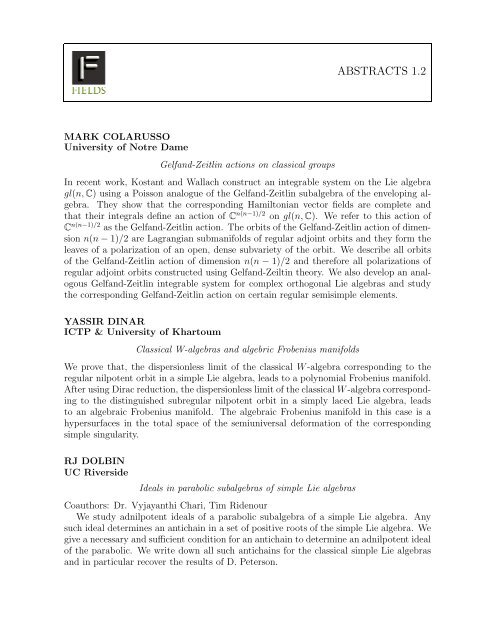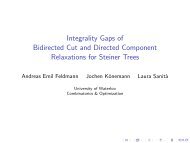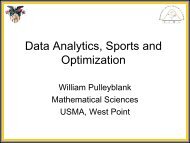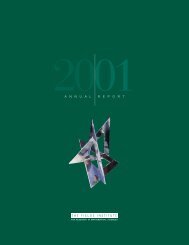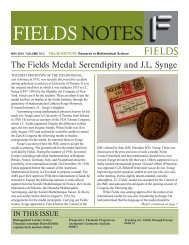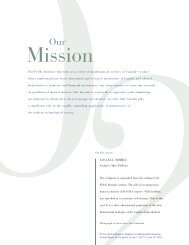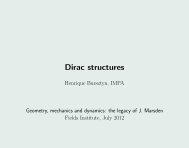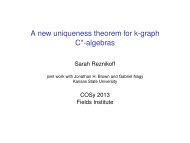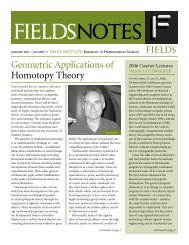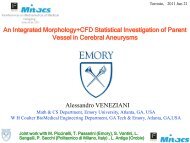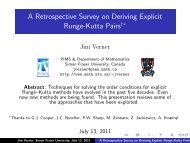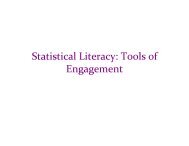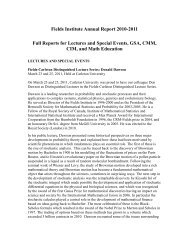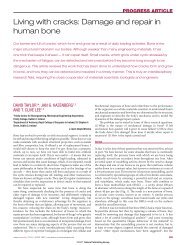ABSTRACTS 1.2 Invited Talks - Fields Institute - University of Toronto
ABSTRACTS 1.2 Invited Talks - Fields Institute - University of Toronto
ABSTRACTS 1.2 Invited Talks - Fields Institute - University of Toronto
You also want an ePaper? Increase the reach of your titles
YUMPU automatically turns print PDFs into web optimized ePapers that Google loves.
MARK COLARUSSO<br />
<strong>University</strong> <strong>of</strong> Notre Dame<br />
Gelfand-Zeitlin actions on classical groups<br />
<strong>ABSTRACTS</strong> <strong>1.2</strong><br />
In recent work, Kostant and Wallach construct an integrable system on the Lie algebra<br />
gl(n, C) using a Poisson analogue <strong>of</strong> the Gelfand-Zeitlin subalgebra <strong>of</strong> the enveloping algebra.<br />
They show that the corresponding Hamiltonian vector fields are complete and<br />
that their integrals define an action <strong>of</strong> C n(n−1)/2 on gl(n, C). We refer to this action <strong>of</strong><br />
C n(n−1)/2 as the Gelfand-Zeitlin action. The orbits <strong>of</strong> the Gelfand-Zeitlin action <strong>of</strong> dimension<br />
n(n − 1)/2 are Lagrangian submanifolds <strong>of</strong> regular adjoint orbits and they form the<br />
leaves <strong>of</strong> a polarization <strong>of</strong> an open, dense subvariety <strong>of</strong> the orbit. We describe all orbits<br />
<strong>of</strong> the Gelfand-Zeitlin action <strong>of</strong> dimension n(n − 1)/2 and therefore all polarizations <strong>of</strong><br />
regular adjoint orbits constructed using Gelfand-Zeiltin theory. We also develop an analogous<br />
Gelfand-Zeitlin integrable system for complex orthogonal Lie algebras and study<br />
the corresponding Gelfand-Zeitlin action on certain regular semisimple elements.<br />
YASSIR DINAR<br />
ICTP & <strong>University</strong> <strong>of</strong> Khartoum<br />
Classical W-algebras and algebric Frobenius manifolds<br />
We prove that, the dispersionless limit <strong>of</strong> the classical W-algebra corresponding to the<br />
regular nilpotent orbit in a simple Lie algebra, leads to a polynomial Frobenius manifold.<br />
After using Dirac reduction, the dispersionless limit <strong>of</strong> the classical W-algebra corresponding<br />
to the distinguished subregular nilpotent orbit in a simply laced Lie algebra, leads<br />
to an algebraic Frobenius manifold. The algebraic Frobenius manifold in this case is a<br />
hypersurfaces in the total space <strong>of</strong> the semiuniversal deformation <strong>of</strong> the corresponding<br />
simple singularity.<br />
RJ DOLBIN<br />
UC Riverside<br />
Ideals in parabolic subalgebras <strong>of</strong> simple Lie algebras<br />
Coauthors: Dr. Vyjayanthi Chari, Tim Ridenour<br />
We study adnilpotent ideals <strong>of</strong> a parabolic subalgebra <strong>of</strong> a simple Lie algebra. Any<br />
such ideal determines an antichain in a set <strong>of</strong> positive roots <strong>of</strong> the simple Lie algebra. We<br />
give a necessary and sufficient condition for an antichain to determine an adnilpotent ideal<br />
<strong>of</strong> the parabolic. We write down all such antichains for the classical simple Lie algebras<br />
and in particular recover the results <strong>of</strong> D. Peterson.


